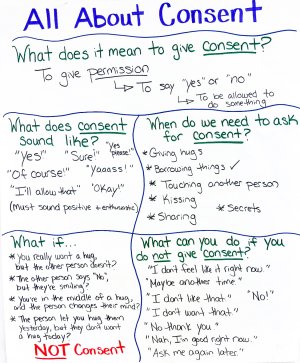Teaching Consent to Elementary Students
Teaching consent in the elementary grades means using nonsexual situations to guide students to assert and respect boundaries.
Your content has been saved!
Go to My Saved Content.A year ago, at the height of the #MeToo movement and with new allegations of sexual assault hitting the news on a seemingly daily basis, third-grade teacher Liz Kleinrock was fed up.
“Where does this toxicity end?” Kleinrock asked herself. “And how can we take proactive measures to stop it?”
Her answer was to teach her students at Citizens of the World Silver Lake Charter School in Los Angeles about consent. After some discussion, Kleinrock and her students created a poster that collected their ideas to create a definition of consent.

Consent is often linked to sex, but it simply means giving permission. When taught to children, it can be applied to a variety of nonsexual situations—giving hugs, borrowing things, and sharing are scenarios Kleinrock’s students came up with.
Although sex is removed from the equation when teaching consent to elementary students, the end goal is to help prevent sexual harassment and assault by teaching students about personal boundaries, how to say no, and how to respect no—and in the unfortunate case that students do experience sexual abuse or harassment, how to ask for help.
One in four girls and one in 20 boys are sexually abused before the age of 18, and about 35 percent of sexual abuse victims are under 12 years old—elementary school age. And in a 2018 national survey, over 80 percent of women and 40 percent of men reported experiencing some form of sexual harassment or assault in their lifetime.
But teaching consent is not just about decreasing the prevalence of sexual violence and harassment, according to Jett Bachman, a K–5 sexuality educator for Day One, a nonprofit focused on ending dating abuse and domestic violence among youth. “It’s also a proactive way of providing young people with the tools they need to have healthy relationships with themselves and other people throughout their lives,” Bachman said.
The Landscape of Consent Education
Teaching consent is a recent development. Ten states and Washington, DC, recommend including consent education as part of sex education; only Oregon and California suggest that consent education start in kindergarten.
The guidance on consent education looks different from state to state. The Oregon Department of Education outlines what to teach: defining consent, describing how relationship power imbalances could impact personal boundaries, and being able to say—and respect hearing—no. California provides sample activities on how to teach consent. But what teachers and schools are missing is explicit instruction on how to teach it.
And not everyone agrees that it’s an educator’s job to teach consent. “It remains the job of the parents to discuss intimacy et al., with their children. Strangers are NOT equipped to speak for me,” parent Anne Fernandes wrote on Facebook in response to an Edutopia article about creating a culture of consent in the classroom.
What Schools Are Doing
Kleinrock’s lessons with her third graders involved anchor charts and journal prompts like, “What does it mean to give consent?” and “Why is consent important?” Her 8- and 9-year-old students wrote things like, “Asking for consent is important because if you didn’t thay midof not wanted to get tuchd.”
To give her kids practice saying yes and no in different situations, Kleinrock had them create comics showing what consent is and isn’t. Most students drew kids asking for a hug.
A Pennsylvania preschool teacher and co-founder of the nonprofit Your Empowered Sexuality (YES!), Isy Abraham-Raveson also uses art to prompt discussion in her classroom. Her students draw examples of when their boundaries have been crossed and present their drawings to the class. She also plays Red, Green, Yellow with students to reinforce the idea of boundaries: After Abraham-Raveson reads out a scenario, students move to a green area of the room if they believe boundaries are being respected, red if they think boundaries have been crossed, and yellow if they’re unsure. When a student moves from one color to another, Abraham-Raveson asks them to explain why.
Although there are teachers like Kleinrock and Abraham-Raveson who have taken on the task of teaching consent themselves, it’s common for schools to hire sexuality educators or work with organizations instead.
Most consent education programs have been created by sexual violence prevention organizations. Abraham-Raveson’s YES! is an outlier. She and two friends trained as sexuality educators and created YES! to give K–12 students the sex and consent education they wish they had gotten.
PowerUp, Speak Out, a multi-lesson program based in Montana, utilizes role-playing in schools to help break down complex concepts around consent. In one lesson, one student repeatedly asks for a hug and a partner comes up with ways to keep saying no without actually using that word.
California-based Verity gives free 45- to 60-minute presentations using the video Consent for Kids and an English-Spanish coloring book to explain safe and unsafe touches, situations when you should say no, and the bathing suit rule—all body parts covered by a bathing suit are private.
Every program and sexuality educator I spoke to prompts students to write down the names of trusted adults they can talk to if anybody ever crosses their boundaries—including someone outside of their family. Ninety percent of kids who are sexually abused know their abuser; almost 50 percent of abused children age 6 and under are abused by a family member.
What Works
One-and-done workshops don’t work, said Alan Berkowitz, a researcher and expert in violence prevention. “A lot of these one-time programs have what’s called the rebound [effect] where you have a positive impact, and then it disappears. One-time programs are not going to produce long-term change.”
Effective consent education can’t be a one-day class or limited to a health class, agreed sexuality expert Laura McGuire—it needs to be integrated throughout the curriculum.
Kleinrock incorporates consent education into core subjects like history and science. When her class is discussing topics like colonization or the water crisis in Flint, Michigan, for example, she may bring up the concept of consent.
“There are ways to approach consent outside of our physical bodies,” she said. “In all of these cases, there is this assumption by the dominant group that, ‘Yes, we can go in. We can take what we want. We can treat you how we want.’”
Gauging the effectiveness of consent education is difficult: It’s hard to know whether it will reduce sexual assault and violence in the future. But that doesn’t mean it’s not impactful. Abraham-Raveson believes that consent education is working when she sees a student stand up for themselves by saying, “You’re touching my body in a way I don’t like,” or when a kid asks for permission to sit on her lap.
Joyce Galindo, a bilingual prevention specialist at Verity, believes that she is succeeding if students leave with the words and tools they need to speak up if they are sexually abused.
After her presentations, Galindo provides time for each student to talk to her privately and ask questions. It’s not unusual for students to disclose that someone has been touching them inappropriately.
It’s common for young kids to believe that what is happening to them is normal, said Galindo. “By talking to kids about safe and unsafe touches and consent,” she added, “if something was to happen to them in the future, they will be able to recognize, ‘No, this is actually not OK.’”
